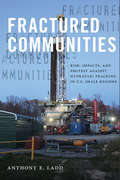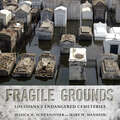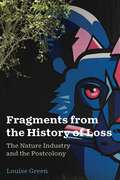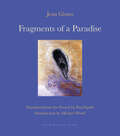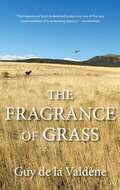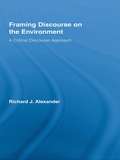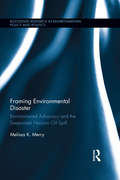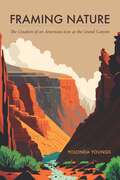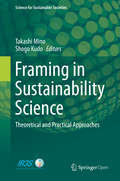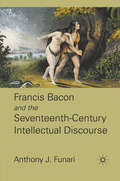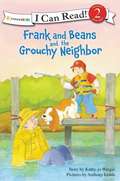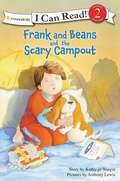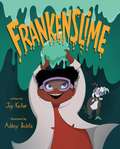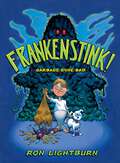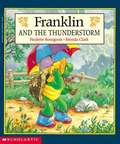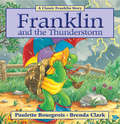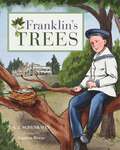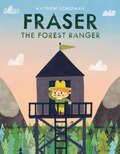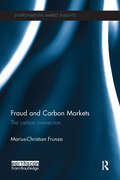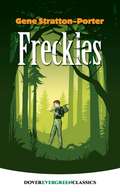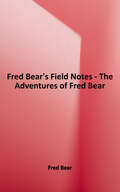- Table View
- List View
Fractured Communities: Risk, Impacts, and Protest Against Hydraulic Fracking in U.S. Shale Regions (Nature, Society, and Culture)
by Peter Hall Stephanie A. Malin Suzanne Staggenborg Anthony E. Ladd Hilary Boudet Sherry Cable Brittany Gaustad James Maples Tamara Mix Carmel Price Dakota K.T. Raynes Stacia Ryder Trang Tran Ion Bogdan Vasi Cameron Thomas Whitley Patricia WidenerWhile environmental disputes and conflicts over fossil fuel extraction have grown in recent years, few issues have been as contentious in the twenty-first century as those surrounding the impacts of unconventional natural gas and oil development using hydraulic drilling and fracturing techniques—more commonly known as “fracking”—on local communities. In Fractured Communities, Anthony E. Ladd and other leading environmental sociologists present a set of crucial case studies analyzing the differential risk perceptions, socio-environmental impacts, and mobilization of citizen protest (or quiescence) surrounding unconventional energy development and hydraulic fracking in a number of key U.S. shale regions. Fractured Communities reveals how this contested terrain is expanding, pushing the issue of fracking into the mainstream of the American political arena.
Fragile Grounds: Louisiana's Endangered Cemeteries (America's Third Coast Series)
by Mary H. Manhein Jessica H. SchexnayderRecipient of a 2018 Preserve Louisiana Award and a 2018 Coastal Stewardship AwardFragile Grounds compiles stories and photographs of endangered cemeteries throughout Louisiana's coastal zone and beyond. These burial places link the fragile land to the frailty of the state's threatened community structures. The book highlights the state's vibrant diversity by showing its unique burial customs and traditions, while it also identifies the urgent need for ongoing documentation of cultural elements at risk.Cemeteries associated with the culturally rich communities of Louisiana reflect the history and global settlement patterns of the state. Yet many are endangered due to recurring natural and man-made events. Nearly 80 percent of the nation's coastal land loss occurs in Louisiana. Coastal erosion, sinking land, flooding, storm surge, and sea-level rise have led to an inland migration that threatens to unravel the fabric of Louisiana and, by association, hastens the demise of its burial places.As people are forced inland, migrants abandon, neglect, or often overlook cemeteries as part of the cultural landscape. In terms of erosion, when the land goes, the cemetery goes with it. Cemeteries fall prey to inland and coastal flooding. As cities grow outward, urban sprawl takes over the landscape. Cemeteries lose out to forces such as expansion, eminent domain, and urban neglect. Not only do cemeteries give comfort for the living, but they also serve as a vital link to the past. Once lost, that past cannot be recovered.
Fragments from the History of Loss: The Nature Industry and the Postcolony (AnthropoScene)
by Louise GreenThe Anthropocene’s urgent message about imminent disaster invites us to forget about history and to focus on the present as it careens into an unthinkable future. To counter this, Louise Green engages with the theoretical framing of nature in concepts such as the “Anthropocene,” “the great acceleration,” and “rewilding” in order to explore what the philosophy of nature in the era of climate change might look like from postcolonial Africa.Utilizing a practice of reading developed in the Frankfurt school, Green rearranges narrative fragments from the “global nature industry,” which subjugates all aspects of nature to the logic of capitalist production, in order to disrupt preconceived notions and habitual ways of thinking about how we inhabit the Anthropocene. Examining climate change through the details of everyday life, particularly the history of conspicuous consumption and the exploitation of Africa, she surfaces the myths and fantasies that have brought the world to its current ecological crisis and that continue to shape the narratives through which it is understood. Beginning with African rainforest exhibits in New York and Cornwall, Green discusses how these representations of the climate catastrophe fail to acknowledge the unequal pace at which humans consume and continue to replicate imperial narratives about Africa. Examining this history and climate change through the lens of South Africa’s entry into capitalist modernity, Green argues that the Anthropocene redirects attention away from the real problem, which is not human’s relation with nature, but people’s relations with each other.A sophisticated, carefully argued call to rethink how we approach relationships between and among humans and the world in which we live, Fragments from the History of Loss is a challenge to both the current era and the scholarly conversation about the Anthropocene.
Fragments from the History of Loss: The Nature Industry and the Postcolony (AnthropoScene: The SLSA Book Series #5)
by Louise GreenThe Anthropocene’s urgent message about imminent disaster invites us to forget about history and to focus on the present as it careens into an unthinkable future. To counter this, Louise Green engages with the theoretical framing of nature in concepts such as the "Anthropocene," "the great acceleration," and "rewilding" in order to explore what the philosophy of nature in the era of climate change might look like from postcolonial Africa.Utilizing a practice of reading developed in the Frankfurt school, Green rearranges narrative fragments from the "global nature industry," which subjugates all aspects of nature to the logic of capitalist production, in order to disrupt preconceived notions and habitual ways of thinking about how we inhabit the Anthropocene. Examining climate change through the details of everyday life, particularly the history of conspicuous consumption and the exploitation of Africa, she surfaces the myths and fantasies that have brought the world to its current ecological crisis and that continue to shape the narratives through which it is understood. Beginning with African rainforest exhibits in New York and Cornwall, Green discusses how these representations of the climate catastrophe fail to acknowledge the unequal pace at which humans consume and continue to replicate imperial narratives about Africa. Examining this history and climate change through the lens of South Africa’s entry into capitalist modernity, Green argues that the Anthropocene redirects attention away from the real problem, which is not human’s relation with nature, but people’s relations with each other.A sophisticated, carefully argued call to rethink how we approach relationships between and among humans and the world in which we live, Fragments from the History of Loss is a challenge to both the current era and the scholarly conversation about the Anthropocene.
Fragments of a Paradise
by Jean Giono&“Giono&’s prose is a singularly fine blend of realism and poetic sensibility.&” — The Washington PostGiono&’s very own Moby-Dick, a sensational maritime journey that follows a crew inwards on a spiritual tale of evocative sea-glimpsesAn allegorical critique of modern civilization and the damages of war, Giono&’s oft-overlooked seafaring tale sweeps the reader along a narrative as poetic and undulating as the wind, tacking between the sea&’s mysteries and the intricacies of the men&’s conversations and inner thoughts as they attempt to grasp the sensory reality around them.&“I no longer have any interest in living under the conditions that this era allows,&” writes the Captain of L&’Indien, a ship whose radio remains packed in a crate in the hold. The men aboard won&’t be needing it; they have no interest in connecting with the world of ordinary men. With enough provisions to last them five years, they set sail in July of 1940 for the South Seas, leaving civilization behind in search of the unknown.Hastening onwards, Giono&’s men steer deeper into themselves, seeking a purpose beyond the &“world in upheaval&” they left behind—a moving and spiritual work written by one of Europe&’s most ardent 20th-century pacifists.A sensational novel that delves into the unknown reaches of the sea and soul, perfect for readers seeking a poetic escape that challenges the political and social status-quo.
Fragrance of Grass
by Guy de la Valdène Martell AgencyAn ode to one man’s lifelong love affair with hunting“Valdène’s wondrous fieldmemoir is a rich sportsman’s miscellany— memorable and erudite fowling lore, camp etiquette, ballistics, poaching ethics, glorious anecdote, bloody ducks, persistent bawdiness, and better wine than you or I'll ever drink—all elegantly spun as an affectionate and sentimental education of loss and renewal. It’s a terrific book.” —Richard Ford Part memoir, part history, The Fragrance of Grass stands as a testament to Guy de la Valdène’s deep love of, and abiding respect for, the natural world and all that inhabit it. Set in places as far afield as France and Montana, Saskatchewan and Florida, this is a beautifully written book that is also an elegant treatise on everything from dogs, birds, and wildlife to food, wine, and women. The Fragrance of Grass will be treasured by all sportsmen and by the readers of Tom McGuane and Jim Harrison. The author’s first book in nearly a decade, it is now being published to coincide with the paperback edition of his classic Red Stag. FROM THE INTRODUCTIONI am watching a thousand feathers—grey partridge feathers—floating high on the surface of the pond in front of the cabin I pretend to work in. I have plucked a million feathers from the bodies of all the grey partridge I have cooked in my life, beautiful golden-brown feathers that match the fall colors of the cypress tress that grow on the edge of my pond. It is November, and all at once winter includes me. On the porch of the cabin there is a wooden rocking chair, weathered and comfortable, that I sit in every day. On quiet afternoons I think about the slowing growth of the loblolly pines I have been watching for twenty years, the everchanging face of the pond now active with fish, and the condition of the natural world outside of my custody. . . . I have hunted at least one hour a day for three months a year, ever since I was eight years old. That translates into more than 5,000 hours in the field, a lifetime walk that, under different circumstances, might have taken me from Paris to Istanbul and back. If to this hike I add the time I have spent shooting . . . I can safely assume that I have had my hands on the stock of a gun for one whole year of the sixty-plus that I have been around. I like to walk, and I know guns.
Frameworks for Water Law Reform
by Sarah HendryThe world is currently experiencing unprecedented global change, with population increase, urbanisation, climate change and environmental degradation combining to make management of freshwater resources a critical policy focus of the twenty-first century. This timely book designs and develops an original, analytical framework for water law reform processes, using case studies across four jurisdictions. Addressing the four principal areas of water law - integrated water resource management (IWRM) and river basin planning, water rights and allocation, water pollution and quality, and water services - this book provides a comprehensive study of water law, within the context of global and regional policy agendas. Case studies from England, Scotland, South Africa and Queensland, Australia, are presented, providing comparators from both common law and mixed jurisdictions, from the northern and southern hemispheres, and from developed and developing countries. A legislative framework is proposed for water law reform processes, and the consequences of different reform options are considered and investigated. A valuable resource for academics and graduate students in environmental law, resource management, hydrology and social science, this book is also highly relevant to policymakers, NGOs and legal practitioners.
Framing Discourse on the Environment: A Critical Discourse Approach (Routledge Critical Studies in Discourse)
by Richard AlexanderIn this study, Richard Alexander presents a series of original and empirically based case studies of the language and discourse involved in the discussion of environmental and ecological issues. Relying upon a variety of different text types and genres – including company websites, advertisements, press articles, speeches and lectures – Alexander interrogates how in the media, press, corporate and activist circles language is employed to argue for and propagate selected positions on the growing ecological crisis. For example, he asks: How are ecological and environmental concerns articulated in texts? What do we learn about ecological ‘problems’ through texts from differing sources? What language features accompany ecological discourse in differing contexts and registers? Attention is especially directed at where this discourse comes into contact with business, economic and political concerns.
Framing Environmental Disaster: Environmental Advocacy and the Deepwater Horizon Oil Spill (Routledge Research in Environmental Policy and Politics)
by Melissa K. MerryThe blowout of the Deepwater Horizon and subsequent underground oil spill in the Gulf of Mexico in 2010 is considered by many to be the worst environmental disaster in U.S. history. Interest groups, public officials, and media organizations have spent considerable time documenting the economic and ecological impacts of this spill as well as the causes of the spill, ostensibly to prevent future disasters of this magnitude. However, rather than an unbiased search for answers, such investigations involve strategic efforts by a variety of political actors to define the spill and its causes in ways that lead to their preferred policy solutions. Framing Environmental Disaster evaluates the causal stories that environmental groups tell about the spill and develops theoretical propositions about the role of such stories in the policy process. Which actors do groups hold responsible, and how do groups use blame attributions to advance their policy agendas? Constructing a creative methodological approach which includes content analysis drawn from blog posts, emails, press releases, and testimony before Congress and insights and quotations drawn from interviews with environmental group representatives, Melissa K. Merry argues that interest groups construct causal explanations long before investigations of policy problems are complete and use focusing events to cast blame for a wide range of harms not directly tied to the events themselves. In doing so, groups seek to take full advantage of “windows of opportunity” resulting from crises. An indispensable resource for scholars of public policy and environmental politics and policy, this book sheds new light on the implications of the gulf disaster for energy politics and policies while advancing scholarly understandings of the role of framing and causal attribution in the policy process.
Framing Nature: The Creation of an American Icon at the Grand Canyon (America’s Public Lands)
by Yolonda YoungsThe Grand Canyon of the Colorado River is an internationally known feature of the North American landscape, attracting more than five million visitors each year. A deep cultural, visual, and social history has shaped the Grand Canyon&’s environment into one of America&’s most significant representations of nature. Yet the canyon is more than a vacation destination, a movie backdrop, or a scenic viewpoint; it is a real place as well as an abstraction easily summoned in the minds of Americans. The Grand Canyon, or the idea of it, is woven into the fabric of American cultural identity and serves as a cultural reference point—an icon. In Framing Nature Yolonda Youngs traces the idea of the Grand Canyon as an icon and the ways people came to know it through popular imagery and visual media. She analyzes and interprets more than fourteen hundred visual artifacts, including postcards, maps, magazine illustrations, and photographs of the Grand Canyon, supplemented with the words and ideas of writers, artists, explorers, and other media makers from 1869 to 2022. Youngs considers the manipulation and commodification of visual representations and shifting ideas, values, and meanings of nature, exploring the interplay between humans and their environments and how visual representations shape popular ideas and meanings about national parks and the American West. Framing Nature provides a novel interpretation of how places, especially national parks, are transformed into national and environmental symbols.
Framing in Sustainability Science: Theoretical and Practical Approaches (Science for Sustainable Societies)
by Takashi Mino Shogo KudoThis open access book offers both conceptual and empirical descriptions of how to “frame” sustainability challenges. It defines “framing” in the context of sustainability science as the process of identifying subjects, setting boundaries, and defining problems. The chapters are grouped into two sections: a conceptual section and a case section. The conceptual section introduces readers to theories and concepts that can be used to achieve multiple understandings of sustainability; in turn, the case section highlights different ways of comprehending sustainability for researchers, practitioners, and other stakeholders. The book offers diverse illustrations of what sustainability concepts entail, both conceptually and empirically, and will help readers become aware of the implicit framings in sustainability-related discourses. In the extant literature, sustainability challenges such as climate change, sustainable development, and rapid urbanization have largely been treated as “pre-set,” fixed topics, while possible solutions have been discussed intensively. In contrast, this book examines the framings applied to the sustainability challenges themselves, and illustrates the road that led us to the current sustainability discourse.
Francis Bacon and the Seventeenth-Century Intellectual Discourse
by Anthony J. FunariThis book explores the resistance of three English poets to Francis Bacon's project to restore humanity to Adamic mastery over nature, moving beyond a discussion of the tension between Bacon and these poetic voices to suggest theywere also debating the narrative of humanity's intellectual path.
Frank Mildmay or the Naval Officer
by Capt. Frederick MarryatFrank Mildmay is a rogue and a rascal who cuts a memorable swath as he moves up the ranks of the early 19th-century Royal Navy. Whether seducing pretty girls ashore, braving hurricanes at sea, or scrambling aboard a French privateer with cutlass bared, Mildmay and his adventures live on!
Frank and Beans and the Grouchy Neighbor (I Can Read! #Level 2)
by Kathy-Jo WarginA Lesson in Forgiveness. Frank can't wait to go fishing--until he finds out Mr. Granger is going too. And Mr. Granger doesn't like dogs! When Beans gets excited, it seems like the trip is ruined. Will Beans be forgiven?
Frank and Beans and the Scary Campout (I Can Read! #Level 2)
by Kathy-Jo WarginA Lesson in Knowing God is Always with You. Frank and Beans are camping in the backyard. But when the sun goes down, Frank hears all kinds of scary noises. And Beans is so scared he runs right out of the tent! What will Frank do now that he's alone? Picture descriptions present.
Frankenslime
by Joy KellerA young slime scientist is surprised when her latest creation comes to life in Frankenslime, a funny and clever picture book twist on Frankenstein. Victoria Franken is a slime scientist.Her experiments lead to amazing slimes. Until, one dark and stormy night, her latest experiment goes awry and her newest creation COMES TO LIFE!Joy Keller’s clever text and Ashley Belote’s humor-filled art combine to create a fun picture book twist on horror movies like Frankenstein and The Blob, that also explores the scientific method and the importance of recording observations and results. The author has also included a couple of Victoria’s best slime recipes, although you'll notice the secret formula that brought her slime to life is missing.
Frankenstink!: Garbage Gone Bad
by Ron LightburnWith vibrant and zany art, this is a book about "garbage" that transforms and mutates into a grotesque, greedy monster devouring everything in its path. Frankenstink! is sure to be a hit with kids who do not like to clean up. Is the monster who feeds on "a mountainous salad of plastic and goo, fast-food leftovers and Styrofoam stew," real, a dream, or a warning of what is to come if we don't compost and recycle? Complemented by playful illustrations in a comic-book style.
Franklin And The Thunderstorm
by Paulette Bourgeois Brenda ClarkAs a thunderstorm approaches, Franklin's friends help him cope with his fear of stormy weather. Picture descriptions added.
Franklin and the Thunderstorm: A Classic Franklin Story (Classic Franklin Stories #19)
by Paulette Bourgeois Brenda ClarkFranklin seeks shell-ter from a storm and learns about the weather in a beloved storybook from the series that inspired the Franklin and Friends TV show! In this Franklin Classic Storybook, Franklin is afraid of thunderstorms. When a storm approaches while he is playing at Fox’s house, a flash of lightning sends Franklin into his shell. He refuses to come out—even for snacks—until his friends make him laugh with their tall tales about what causes storms. And when Beaver explains what really causes thunder and lightning, Franklin begins to feel much safer.
Franklin's Trees
by A.J. Schenkman&“All that is within me cries out to go back to my home on The Hudson River,&” President Franklin Roosevelt once declared. For it was at his home in Hyde Park, New York that FDR could indulge in his favorite avocation—&“tree farmer.&” This book introduces children to FDR&’s love of nature through a lifetime in which he oversaw the planting of over a million trees on his estate. It tells of a childhood hiking the trails through his forest, later widening those trails into roads after polio deprived him of the use of his legs and only able to get around by car. It describes the creation of the Civilian Conservation Corps during the Great Depression, which came to be known as &“Roosevelt&’s Tree Army.&” It also tells the story of how FDR sent England&’s Prime Minister Winston Churchill a Norway spruce one Christmas to cheer up the English people. Today, FDR&’s love of trees is remembered at the Franklin D. Roosevelt Historic Site in Hyde Park, New York, where many of the trees he planted still rise on the grounds and surrounding forest.
Fraser the Forest Ranger
by Matthew SchufmanFraser the Forest Ranger is on a mission: to find one true friend. He searches far and wide, but he might just discover a best friend is closer than he thinks.Fraser is a Forest Ranger and he loves his job. He checks on the trees, he checks on the animals, and he always ends his day with a stack of pancakes by the fire. But being a forest ranger can get lonely. Fraser spends his nights, weekends, and even birthdays alone. So, Fraser sets out to find a friend. He travels far. But the beach is too hot, the zoo makes him miss his own animal friends back home, and everyone in the city is too busy. All hope seems lost, but could it be that Fraser is just one wrong turn away from a true friend after all?Matthew Schufman&’s heartwarming debut featuring his bold and expressive illustrations make Fraser the Forest Ranger a friend that young readers will be asking to visit again and again.
Fraud and Carbon Markets: The Carbon Connection (Environmental Market Insights)
by Marius-Christian FrunzaThe VAT Carousel Fraud has seriously undermined the financial integrity of the European Union Emissions Trading Scheme (EU ETS). This timely book is the first to give an overview of fraud in the carbon market. Written by a former broker, it presents unique material on the carbon fraud mechanics and analyses the missing trader fraud (VAT fraud) on European carbon allowances markets with a focus on financial and organised crime issues. Fraud and Carbon Markets: The Carbon Connection assesses the weaknesses of the Kyoto Protocol and environmental markets, using statistics as a forensic tool on the capital markets. It describes specific cases, the court investigations and various mechanisms. It addresses issues of money laundering and international fraud on capital markets, such as stock manipulation, by exploring the financial mechanisms of the fraud, their impact on the market behaviour and the consequences on their econometric features. Researchers and students in climate change policy, environmental finance, financial law, organised crime, forensic statistics, financial regulation and risk management as well as financial regulators and policy makers will find this book of great interest.
Freaky, Funky Fish: Odd Facts about Fascinating Fish
by Debra Kempf ShumakerFrom zapping, stinging, even singing, to playing dead or having a see-through head, discover the interesting things different fish do to survive in this delightful non-fiction picture book. Fish have fins and gills and tails. All fish swim and most have scales. But not all fish act or look the same. From zapping, stinging, even singing, Freaky, Funky Fish: Odd Facts about Fascinating Fish is an adorable picture book with a scientific—and child-friendly—underpinning. With examples of different fish for each description, as well as extensive backmatter explaining the fascinating science behind these variety of fish, this funky book captures the wonder of our ecosystem.
Freckles
by Gene Stratton-PorterIn this companion book to the much-loved classic A Girl of the Limberlost, an orphaned teenager longs to find his place in the world. Freckles was discovered on the doorstep of a Chicago orphanage, badly beaten and missing a hand. He yearns for the fulfillment of useful work, and at Indiana's Limberlost Swamp, his grit and determination win him the difficult, dangerous job of guarding a valuable stand of timber. Faithful and brave in his daily tasks, Freckles comes to appreciate the beauty and majesty of the natural world amid the wetlands' sights, sounds, and silences.As nature works miracles in the boy's lonely, starved heart, Freckles meets a kind and gentle girl who collects specimens for a wildlife photographer. Despite his growing love for his Swamp Angel, Freckles feels himself far below her station — until the opportunity arises for him to prove his true worth.
Fred Bear's Field Notes: The Adventures of Fred Bear
by Fred BearA classic collection of Fred Bear's hunts and adventures. Fred Bear is known for being one of the most popular and successful outdoorsmen to date. His passion and skill for archery led him to create the successful Bear Archery company. In Fred Bear's Field Notes: The Adventures of Fred Bear, Fred Bear shares all of his personal reflections and field notes in this great 288-page book. 100 photos capture his international hunting expeditions.
